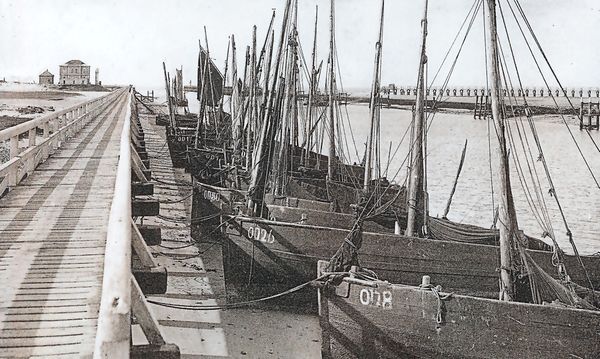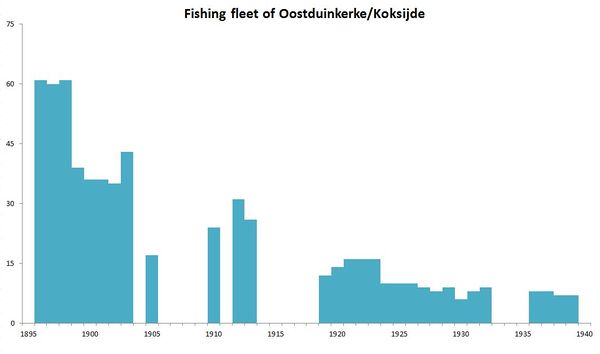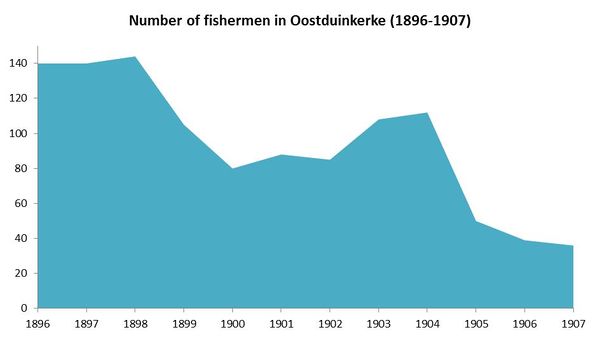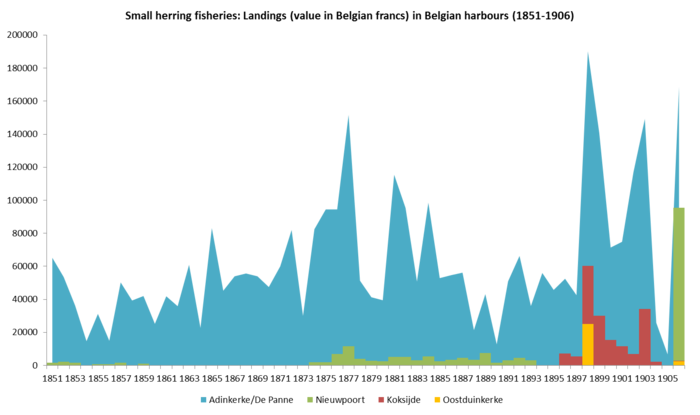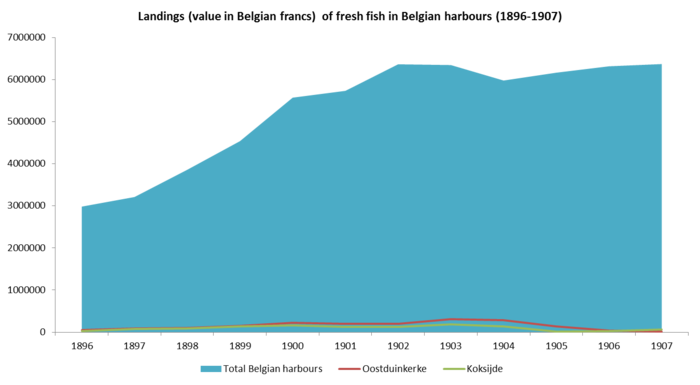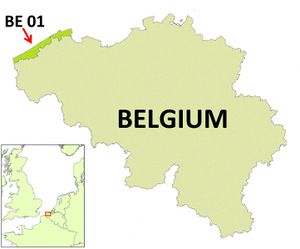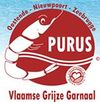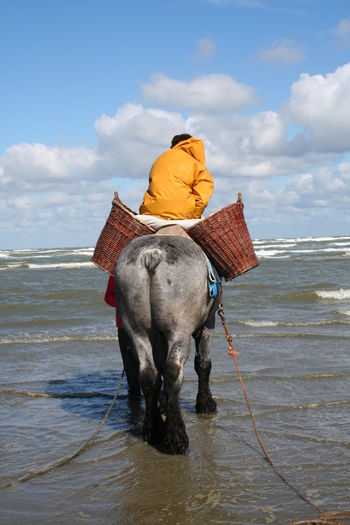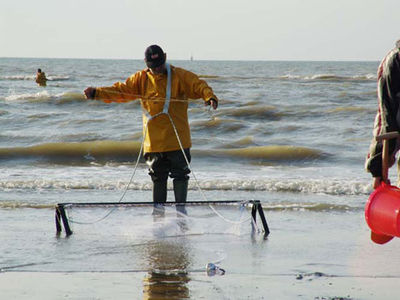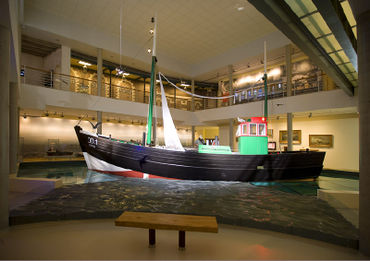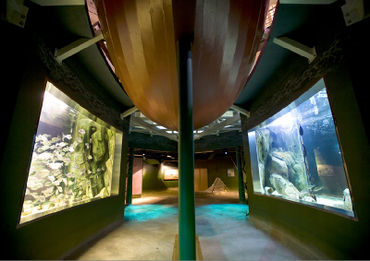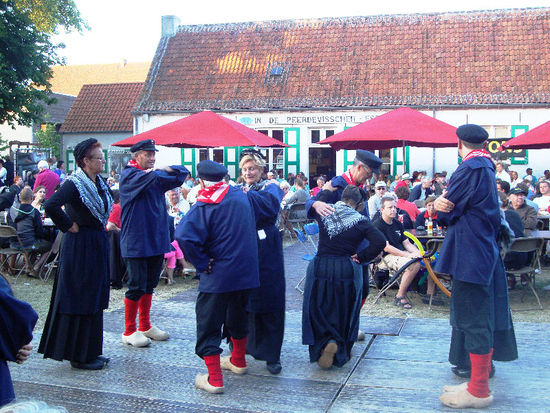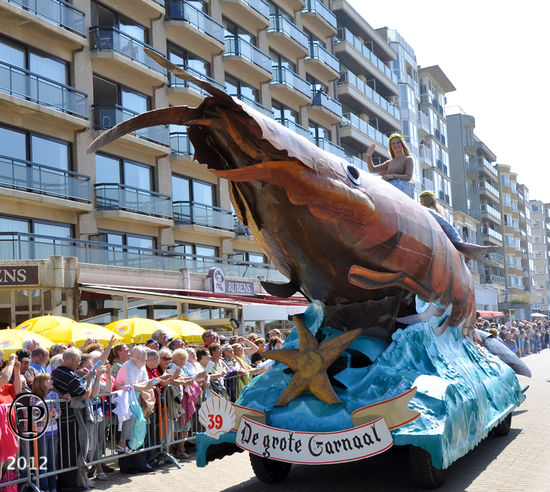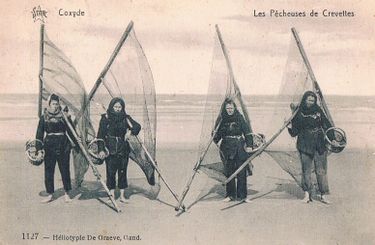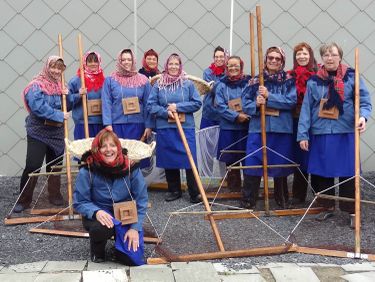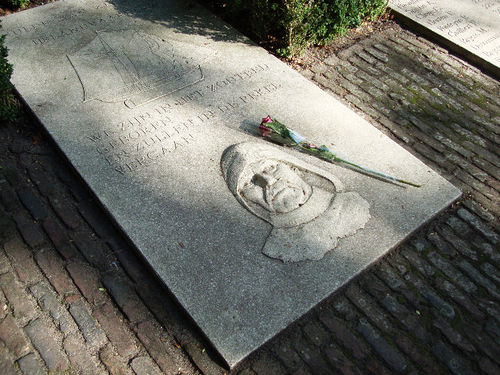Difference between revisions of "Fisheries in Oostduinkerke"
(→Fisheries related activities) |
(→Branding) |
||
| (60 intermediate revisions by 3 users not shown) | |||
| Line 4: | Line 4: | ||
The Belgian coast is 67 km long and is entirely bordering the province of West-Flanders (region of Flanders, Belgium). The Belgian part of the North Sea is 3,457 km<sup>2</sup> (0.5% of the North Sea area), of which more than 1/3 or 1,430 km² are territorial sea within 12 nautical miles distance of the coastline. Belgium currently has 10 coastal municipalities and 4 coastal ports (Nieuwpoort, Oostende, Zeebrugge and Blankenberge), and besides the fish auctions located in Oostende, Zeebrugge and Nieuwpoort where fish is sold according to legal procedures, there are no other dispersed landing points. Although historically the port and auction of Oostende was by far the most important, today the auctions of Zeebrugge (53%) and Oostende (45%) receive the largest share of the landings of Belgian fisheries in Belgian ports. | The Belgian coast is 67 km long and is entirely bordering the province of West-Flanders (region of Flanders, Belgium). The Belgian part of the North Sea is 3,457 km<sup>2</sup> (0.5% of the North Sea area), of which more than 1/3 or 1,430 km² are territorial sea within 12 nautical miles distance of the coastline. Belgium currently has 10 coastal municipalities and 4 coastal ports (Nieuwpoort, Oostende, Zeebrugge and Blankenberge), and besides the fish auctions located in Oostende, Zeebrugge and Nieuwpoort where fish is sold according to legal procedures, there are no other dispersed landing points. Although historically the port and auction of Oostende was by far the most important, today the auctions of Zeebrugge (53%) and Oostende (45%) receive the largest share of the landings of Belgian fisheries in Belgian ports. | ||
| − | Belgium has a minor role in the European fisheries context with 0.35% of the total EU production of fish. In 2012, the Belgian commercial sea fishing fleet counted 86 ships, with a total engine capacity of 49,135 kW and gross tonnage of 15,326 GT <ref name="Roegiers"> [http://www.vliz.be/en/imis?module=ref&refid=224957 Roegiers, B.; Platteau, J.; Van Bogaert, T.; Van Gijseghem, D.; Bekaert, K.; De Bruyne, S.; Delbare, D.; Depestele, J.; Lescrauwaet, A.-K.; Moreau, K.; Polet, H.; Robbens, J.; Vandamme, S.; Van Hoey, G.; Verschueren, B. (2013). VIRA Visserijrapport 2012 Departement Landbouw en Visserij: Brussel. 98 pp.] </ref>. 45 vessels are part of the Small Fleet Segment (max 221 kW engine power) of which 2 use passive gear. The remaining 41 vessels belong to the Large Fleet Segment and have an engine power between 221 kW and a maximum of 1,200 kW. This fleet segment represents approximately 80% of the engine power capacity and 77% of the | + | Belgium has a minor role in the European fisheries context with 0.35% of the total EU production of fish. In 2012, the Belgian commercial sea fishing fleet counted 86 ships, with a total engine capacity of 49,135 kW and gross tonnage of 15,326 Gross Tonnage (GT) <ref name="Roegiers"> [http://www.vliz.be/en/imis?module=ref&refid=224957 Roegiers, B.; Platteau, J.; Van Bogaert, T.; Van Gijseghem, D.; Bekaert, K.; De Bruyne, S.; Delbare, D.; Depestele, J.; Lescrauwaet, A.-K.; Moreau, K.; Polet, H.; Robbens, J.; Vandamme, S.; Van Hoey, G.; Verschueren, B. (2013). VIRA Visserijrapport 2012 Departement Landbouw en Visserij: Brussel. 98 pp.] </ref>. 45 vessels are part of the Small Fleet Segment (max 221 kW engine power) of which 2 use passive gear. The remaining 41 vessels belong to the Large Fleet Segment and have an engine power between 221 kW and a maximum of 1,200 kW. This fleet segment represents approximately 80% of the engine power capacity and 77% of the Gross Tonnage of the fleet. While a smaller number use trammel nets (passive gear) and otter trawl, the largest share of the Large Fleet Segment are beam trawl vessels (≥662 kW). The Belgian fleet is highly specialized: more than 68% of the effort(days at sea) and 77% of total landings are achieved by beam trawlers(2010)focusing primarily on flatfish species such as plaice (<i>Pleuronectes platessa</i>) and sole (<i>Solea solea</i>). The results of the reconstruction of the Belgian fleet dynamics since 1830 are presented in Lescrauwaet et al. 2013<ref name="LescrauwaetPhD">[http://www.vliz.be/en/imis?module=ref&refid=228661 Lescrauwaet, A.-K. (2013). Belgian fisheries: ten decades, seven seas, forty species: Historical time-series to reconstruct landings, catches, fleet and fishing areas from 1900. PhD Thesis. Ghent University (UGent): Gent. xiii, 242 pp.] </ref>. |
The number of days at sea per vessel is fixed at a maximum of 265 per year and in 2011 the entire fleet realized a fishing effort of 15,855 days at sea. In 2011, the Belgian fleet landed a total of 20,138t, of which 16,905t were landed in Belgian ports. Plaice is the most important species in terms of landed weight. The landings of 2011 represented a value of €76.3 million, 14% of which was marketed in foreign ports. Sole generates 47% of the current total value of fisheries in Belgium. The Belgian sea fisheries represent 0.04% of the national Gross Domestic Product <ref> [http://www.vliz.be/en/imis?module=ref&refid=131093 Anon. (2008). Strategische Milieubeoordeling van het Nationaal Operationeel Plan voor de Belgische visserijsector, 2007 - 2013. ILVO Visserij: Oostende. 103 pp.]</ref>. The main fishing grounds in terms of volume of landings in 2010 were in descending order: North Sea South (IVc), Eastern English Channel (VIId), North Sea Central (IVb), Southeast Ireland/Celtic Sea (VIIg) Bristol Channel (VIIf) and Irish Sea (VIIa). | The number of days at sea per vessel is fixed at a maximum of 265 per year and in 2011 the entire fleet realized a fishing effort of 15,855 days at sea. In 2011, the Belgian fleet landed a total of 20,138t, of which 16,905t were landed in Belgian ports. Plaice is the most important species in terms of landed weight. The landings of 2011 represented a value of €76.3 million, 14% of which was marketed in foreign ports. Sole generates 47% of the current total value of fisheries in Belgium. The Belgian sea fisheries represent 0.04% of the national Gross Domestic Product <ref> [http://www.vliz.be/en/imis?module=ref&refid=131093 Anon. (2008). Strategische Milieubeoordeling van het Nationaal Operationeel Plan voor de Belgische visserijsector, 2007 - 2013. ILVO Visserij: Oostende. 103 pp.]</ref>. The main fishing grounds in terms of volume of landings in 2010 were in descending order: North Sea South (IVc), Eastern English Channel (VIId), North Sea Central (IVb), Southeast Ireland/Celtic Sea (VIIg) Bristol Channel (VIIf) and Irish Sea (VIIa). | ||
| Line 29: | Line 29: | ||
---- | ---- | ||
| − | The number of fishermen in Oostduinkerke that were employed onboard of fishing vessels is illustrated in graph | + | Oostduinkerke/Koksijde had a small number of inshore fishing vessels during the 19th and beginning of the 20th century. The highest number of fishing vessels in Oostduinkerke/Koksijde was recorded in 1896 with 61 fishing vessels. Since then the fleet started to decline. In 1939 the number of ships decreased to 7 inshore fishing vessels. Since 1942, Oostduinkerke is not mentioned in the [http://www.vliz.be/nl/open-marien-archief?module=ref&refid=200137 Officieele lijst der visschersvaartuigen]. |
| + | |||
| + | [[Image:Fleet_Oostduinkerke.JPG|center|600px|]] | ||
| + | :::Graph 1: Fishing fleet in Oostduinkerke/Koksijde (Source:'''1872-1903''': [http://www.vliz.be/nl/imis?module=ref&refid=42954 ICES Fisheries Statistics = Bulletin Statistique des Pêches Maritimes] 1903, '''1905''': [http://www.vliz.be/nl/imis?module=ref&refid=36108 De Zuttere (1909). Enquête sur la pêche maritime en Belgique], '''1910''': [http://www.vliz.be/nl/catalogus?module=ref&refid=127278 Von Schoen, F. (1912). La pêche maritime de la Belgique], '''1928''': [http://www.vliz.be/nl/open-marien-archief?module=ref&refid=200137 Officieele lijst der visschersvaartuigen]). | ||
| + | |||
| + | The number of fishermen in Oostduinkerke that were employed onboard of fishing vessels is illustrated in graph 2. Oostduinkerke reached the highest number of fishermen in 1898: at that time 144 fishermen were active. Afterwards, the number of fishermen started to decline <ref name= "De Zuttere">[http://www.vliz.be/en/imis?module=ref&refid=36108 De Zuttere, C. (1909). Enquête sur la pêche maritime en Belgique: introduction, recencement de la pêche maritime. Lebègue & cie: Bruxelles. 634 pp]</ref>. | ||
[[Image:Graph_2_Oostduinkerke.jpg|center|600px|]] | [[Image:Graph_2_Oostduinkerke.jpg|center|600px|]] | ||
| − | :::Graph | + | :::Graph 2: Number of ‘fleet' fishermen in Oostduinkerke (1896-1907) (Source: [http://www.vliz.be/en/imis?module=ref&refid=36108 De Zuttere, 1909]). |
| + | |||
| + | ===<span style="color:#3a75c4; Font-size: 130%">'''<small>Landings</small>'''</span>=== | ||
| + | ---- | ||
| + | |||
| + | Data about the landing of fish in Oostduinkerke and Koksijde are only available from 1896 onwards in [http://www.vliz.be/nl/open-marien-archief?module=ref&refid=36108 Dezuttere, 1909] and are written down in the old currency of the Belgian franc. Around the turn of the century, Koksijde and Oostduinkerke where involved in what was called the small herring fisheries: the catch of fresh herring close to the coast. This type of fishery was mainly practiced by fishers from [[Fisheries in De Panne|De Panne]], but could also be found in Koksijde/Oostduinkerke and Nieuwpoort. This type of small herring fishery quickly descended shortly after the turn of the century, when its industrial importance grew smaller <ref name="De Zuttere"/>. | ||
| + | |||
| + | [[Image:Graph 4 De Panne - haring BEF.png|center|700px|]] | ||
| + | :::Graph 3: Small herring fisheries: Landings (in Belgian francs) in Oostduinkerke and Koksijde and other Belgian harbours (Source: [http://www.vliz.be/en/imis?module=ref&refid=36108 De Zuttere, 1909]). | ||
| + | |||
| + | Also in [http://www.vliz.be/nl/open-marien-archief?module=ref&refid=36108 Dezuttere, 1909], the annual landing of ‘fresh fish’ was recorded during the period 1896-1907. The category ‘fresh fish’ refers to fish caught by coastal fishing vessels. A further classification by species is unfortunately not available. | ||
| + | |||
| + | [[Image:Graph_4_ODK_juist.png|center|700px|]] | ||
| + | :::Graph 4: Landings (in Belgian francs) of fresh fish in Oostduinkerke (red line) and Koksijde (green line) (Source: [http://www.vliz.be/en/imis?module=ref&refid=36108 De Zuttere, 1909]). | ||
| + | |||
| + | ===<span style="color:#3a75c4; Font-size: 130%">'''<small>Governance and Organisations</small>'''</span>=== | ||
| + | ---- | ||
| + | In Belgium, the '''FLAG''', also called the ‘local group’, ‘Plaatselijke Groep Belgisch Zeevisserijgebied’, is a partnership between socio-economic stakeholders in the fisheries sector, NGOs and public authorities that play a crucial role in the implementation of the proposed development strategy. The lead partner of the Belgian FLAG is the Province of West Flanders. The main focus of the FLAG strategy is to add value to local fisheries products and increase local consumption. Belgian landings represent only 10% of fisheries products consumed in Belgium, leaving the remaining 90% to be met by imports. Therefore there is a considerable potential for discovering and developing local markets. It will also support diversification, innovation, the involvement of women and efforts to promote the sustainable management of the marine environment<ref>[https://webgate.ec.europa.eu/fpfis/cms/farnet/flagsheet/flag-factsheet-belgium-west-flanders FLAG factsheet - Belgium - West Flanders]</ref>. | ||
| + | |||
| + | [[Image:FLAG.jpg|center|300px|]] | ||
| + | ::::::::::::Fig. 6. [https://webgate.ec.europa.eu/fpfis/cms/farnet/belgian-flag-factsheet Belgian FLAG area: West Flanders] | ||
| + | |||
| + | The '''‘[http://ordevandepaardevisser.eu/index.html Orde van de Paardevisser]’''' (''‘Order of the Horse Fisherman’'') was founded in Oostduinkerke in 1967. The goals of this organization include the preservation of the shrimp fisheries on horseback, encouraging tourism in Oostduinkerke and Koksijde and promoting gastronomy in general and the local shrimp in particular. A number of activities are organized every year to achieve these objectives. | ||
| + | |||
| + | The non-profit organisation '''‘[http://en.navigomuseum.be/friends%20and%20partners Vrienden van het Nationaal Visserijmuseum van Oostduinkerke]’''' (''‘Friends of the National Fisheries Museum of Oostduinkerke’'') dedicates itself to acquiring new pieces | ||
| + | for the collections of the NAVIGO - National Fisheries Museum (see Fisheries related activities) and to publicizing the museum, by means of organizing several fisheries-related activities. They also have an advisory role in the further development of the museum <ref>[http://www.watererfgoed.be/Docs/BehoudenVaartInhoud.pdf VCM-Brochure Behouden Vaart. Varend Erfgoed(verenigingen) in Vlaanderen.]</ref>. | ||
| + | |||
| + | Nowadays, a group of around 12 '''[http://www.paardevissers.be/ shrimp fisherman on horseback]''' is still based in Oostduinkerke. Furthermore, the town also has two flourishing associations of '''shrimp fishermen on foot''': the [http://inwoner.koksijde.be/gidsendetail.aspx?id=224 Slepers] and the [http://inwoner.koksijde.be/gidsendetail.aspx?id=156 Spanjaardbank]. Together they count fifty members, men and women who practice it as a unique form of fishing <ref name="foot"> [http://visitor.koksijde.be/product/2226/shrimpfishermen-on-foot Shrimp fishermen on foot], Site Gemeente Koksijde. </ref>. | ||
| + | |||
| + | ===<span style="color:#3a75c4; Font-size: 130%">'''<small>Branding</small>'''</span>=== | ||
| + | ---- | ||
| + | [[Image:Purus.jpg|100px|thumb|left|link=]] | ||
| + | The Flemish brown shrimp is a typical fisheries product in Belgium. In 2006 the '''Purus label''' was introduced by a cooperation of ship owners, the cooperative Flemish fisheries organization (Cooperative Vlaamse Visserij Vereniging CVBA) to promote the Flemish unpeeled brown shrimps. The brown shrimps are caught by Belgian fishermen, the fishermen fish no longer than 24 hours and the shrimps are cooked in old Flemish manner (in sea water with salt), there are no additives, preservatives added. This all results in high quality taste. The Purus label also promotes sustainable fishing techniques. | ||
| − | |||
| − | [[Image: | + | [[Image:North_Sea_Life.jpg|100px|thumb|left|link=]] |
| − | + | Since 2011, the Flemish Shellfish- and fish cooperation (VSVC) supply, via an exclusive quality label, '''North Sea Life''', life brown shrimps and swimming crabs to restaurants and wholesalers. Life shrimps allows chefs to determine how they will prepare the shrimps. Life product forms the base of creative and gastronomic possibilities. The same is true for life swimming crabs. In 2013 a minimum of 200 kilo life brown shrimps were landed each day. Prices for life shrimps are on average 30 percent higher than shrimps cooked on board of the shrimp vessel<ref>[http://www.ilvo.vlaanderen.be/NL/Persenmedia/Allemedia/tabid/6294/articleType/ArticleView/articleId/1105/language/nl-NL/ILVO-ziet-in-rauwe-garnaal-meer-dan-lucratieve-niche.aspx#.UyBv6vldVSL ILVO ziet in rauwe garnaal meer dan lucratieve niche]</ref>. | |
| + | <br style="clear:both"/> | ||
| − | ===<span style="color:#3a75c4; Font-size: 130%">'''<small>Fish | + | ===<span style="color:#3a75c4; Font-size: 130%">'''<small>Fish as Food</small>'''</span>=== |
---- | ---- | ||
| Line 52: | Line 89: | ||
There are only a few '''fish shops''' in Oostduinkerke. In 2012 one of the most well known fish shops of Oostduinkerke, run by the family Messiaen, closed its doors after 75 years of activity <ref> [http://www.nieuwsblad.be/article/detail.aspx?articleid=DMF20120625_00199168 Article 'Het Nieuwsblad', June 26th 2012.]</ref>. With the closure of this shop, there are only two fish shops left, [http://www.goudengids.be/vishandel-rudy-oostduinkerke-8670/ 'Rudy'] and [http://www.fishtrading.be/ 'Le Breton']. However, more fish shops can be found in Koksijde (click [https://www.google.be/maps/search/koksijde+viswinkel/@51.114190,2.631020,13z here] for an overview). | There are only a few '''fish shops''' in Oostduinkerke. In 2012 one of the most well known fish shops of Oostduinkerke, run by the family Messiaen, closed its doors after 75 years of activity <ref> [http://www.nieuwsblad.be/article/detail.aspx?articleid=DMF20120625_00199168 Article 'Het Nieuwsblad', June 26th 2012.]</ref>. With the closure of this shop, there are only two fish shops left, [http://www.goudengids.be/vishandel-rudy-oostduinkerke-8670/ 'Rudy'] and [http://www.fishtrading.be/ 'Le Breton']. However, more fish shops can be found in Koksijde (click [https://www.google.be/maps/search/koksijde+viswinkel/@51.114190,2.631020,13z here] for an overview). | ||
| − | ===<span style="color:#3a75c4; Font-size: 130%">'''<small> | + | ===<span style="color:#3a75c4; Font-size: 130%">'''<small>Tourism/Education</small>'''</span>=== |
---- | ---- | ||
| − | |||
| − | |||
| + | *Oostduinkerke is famously known as the only place in the world where you can still see '''shrimp fishermen on horseback'''. The shrimp fishing takes place at low tide, both in summer and winter, for about two hours, i.e. one hour before and one hour after low water. The fishermen are clad in traditional southwester, bright yellow oilskins and rubber waders. The horses that are used are usually robust stallions of the Brabant or Hainaut breed, for this type of fishery requires exceptional strength and powers of resistance. Breast deep in water, the horses advance at a steady pace, dragging the nets up. From time to time, the fishermen and his horse leave the water to empty the net and to put the contents into two wicker baskets fixed on each side of the horse. As soon as the fisherman returns home, the shrimps are cooked and offered for sale by the fisherman and his wife <ref>[http://visitor.koksijde.be/product/2225/shrimpfishermen-on-horseback Shrimp fishermen on horseback], Site Gemeente Koksijde.</ref>. During the tourist season, visitors are treated to demonstrations from the fishing itself to shrimp cooking (a [http://visitor.koksijde.be/product/2225/shrimpfishermen-on-horseback calendar] is available), but during the school period in spring and autumn, groups and classes can also make [http://www.paardenvissers.be/ appointments] to observe this unique collaboration of man, horse and sea up close <ref>[http://www.paardenvissers.be/ Site Paardenvissers Oostduinkerke]</ref>. | ||
| + | |||
| + | *On a regular basis, the beach of Oostduinkerke is also populated with ''‘kruiers’'' or ''‘kruwers’'', which are '''shrimp fishermen on foot'''. In fact they play "horse" themselves because they pull their net through the sea water themselves. As mentioned before, Oostduinkerke still has two associations of these type of fishermen, which adds up to about fifty men and women who practice this unique form of fishing <ref name="foot"/>. The members of the club [http://inwoner.koksijde.be/gidsendetail.aspx?id=224 De Slepers] give group demonstrations of their shrimp fishing techniques and subsequently share their fresh shrimp on the seawall of Oostduinkerke. The club aims to promote the activity, which is part of the cultural patrimony of the town, with both tourists as second residents. | ||
| + | |||
| + | {|style="margin:10px auto" | ||
| + | | [[Image:Fig_3._Garnaalvisser_te_paard.jpg|center|350px|]] | ||
| + | :Fig. 3. A shrimp fisherman on horseback in Oostduinkerke (© [http://www.vliz.be/nl/multimedia/luchtfotos?album=226&pic=2956 Onze kust / VLIZ (Delva), 2006]). | ||
| + | | [[Image:Fig_4._kruien.jpg|center|400px|]] | ||
| + | :Fig. 4. A shrimp fisherman on foot in Oostduinkerke (© [http://visitor.koksijde.be/product/2226/shrimpfishermen-on-foot Gemeente Koksijde]). | ||
| + | |} | ||
| − | + | *Oostduinkerke has two '''museums''' related to fisheries. | |
| − | + | ::The '''[http://visitor.koksijde.be/product/2244/the-museum-florishof Museum Florishof]''' shows the life in rural villages around 1900. This museum of local history consists of, amongst other things, an authentic fishermen’s house and presents old crafts and folkloristic objects. | |
| + | ::In the centre of Oostduinkerke, the '''National fishery museum [http://nl.navigomuseum.be/ NAVIGO]''' is situated. This museum tells the history of the Flemish sea and coastal fishing industry and informs its visitors, amongst other things, about the living conditions and lifestyle of the Flemish fisherman at the west coast, beach fishing and beachcombing, superstition versus popular belief of the fisherman's family, etc. Apart from this focus on the past, the museum also pays attention to the present and future of fishing in the North Sea<ref>[http://visitor.koksijde.be/product/2246/national-fishery-museum-oostduinkerke National fishery museum], Site Gemeente Koksijde.</ref><ref>[http://en.navigomuseum.be/ Site NAVIGO]</ref>. The central part of the NAVIGO-exhibition is the [http://bezoeker.koksijde.be/product/1542/kustvissersvaartuig-od-1-martha coastal fishing vessel OD.1 Martha]. This ship was originally build in 1942 and is a well-preserved example of a wooden coastal fishing vessel from World War II. Since 1998, it is recognized as a protected monument <ref>[http://bezoeker.koksijde.be/product/1542/kustvissersvaartuig-od-1-martha Kustvissersvaartuig OD.1 Martha], Site Gemeente Koksijde.</ref>. The museum also houses two [http://en.navigomuseum.be/productgroep/1017/2513/aquariums salt-water '''aquariums'''], containing the most-caught North Sea fish. | ||
| − | + | {|style="margin:10px auto" | |
| − | - | + | | [[Image:Fig_5._OD1._Martha_-_Bron_Navigo.jpg|center|370px|]] |
| − | + | Fig. 5. The wooden coastal fishing vessel OD.1 Martha displayed in the NAVIGO museum (© NAVIGO - Nationaal Visserijmuseum, Gemeente Koksijde). | |
| + | | [[Image:Fig_6._aquarium_Navigo_-_Bron_NAVIGO_-_Nationaal_Visserijmuseum,_Gemeente_Koksijde.jpg|center|370px|]] | ||
| + | :Fig. 6. A view of the aquariums in the National fishery museum (© NAVIGO - Nationaal Visserijmuseum, Gemeente Koksijde). | ||
| + | |} | ||
| − | + | *The NAVIGO-museum is closely involved with the '''rich folkloric life''' in town, and tries to involve the tradition of shrimp fishing on foot or horseback as much as possible in the working of the museum. | |
| − | |||
| − | + | ::Traditionally, for example, a '''‘Paardenvissers in het museum’-day''' (''‘Shrimp fishermen on horseback in the museum’-day'') is organized. On that day, the fishermen drag their nets to the museum, where they prepare the catch of the day on the museum square. The two associations of shrimp fishermen on foot (the [http://inwoner.koksijde.be/gidsendetail.aspx?id=224 Slepers] and the [http://inwoner.koksijde.be/gidsendetail.aspx?id=156 Spanjaardbank]) are also present with snacks from the sea. On this day, the museum can be visited free of charge <ref>[http://www.westhoek.be/nieuws/46331/paardenvissers-in-het-navigo-museum-op-20-oktober-2013 Paardenvissers in het NAVIGO-museum], Site Westhoek.be. </ref>. | |
| − | + | ::During the summer months, the NAVIGO-museum, the non-profit organisation [http://en.navigomuseum.be/friends%20and%20partners ‘Vrienden van het Nationaal Visserijmuseum van Oostduinkerke’] (''‘Friends of the National Fisheries Museum’'') and the museum tavern ‘De Peerdevisscher’ organize the '''‘Visserijfolkloreavonden’''' (''‘Fishing folklore evenings’''). Every Friday evening in July and August, in the courtyard of the National fishery museum, the life of the local fishing community in the olden days is shown: several old fishing crafts are demonstrated, fresh shrimps are prepared and peeled, fish are fried and music and dancing are performed in traditional clothing <ref>[http://www.watererfgoed.be/EG_folkloreavonden.aspx#Festival Visserijfolkloreavonden], Site Watererfgoed Vlaanderen, een zee van tradities.</ref><ref>[http://www.westhoek.be/jewaserbij/2711/visserijfolklore-avond Visserijfolkloreavonden], Site Westhoek.be</ref>. | |
| − | + | [[Image:Fig_8._visserijavonden.jpg|center|550px|]] | |
| + | ::Fig. 7. Dancing in traditional clothing during the ‘Fishing folklore evenings’ (© NAVIGO - Nationaal Visserijmuseum, Gemeente Koksijde). | ||
| − | + | *Since 1950, every year during the last weekend of June, the [http://bezoeker.koksijde.be/activiteitendetail/8094/garnaalfeesten ‘Garnaalfeesten’] (''‘Shrimp Festival’'') take over the village of Oostduinkerke. The event is intended as an annual tribute to the sea in general and shrimp fishing in particular. During the first day of the '''Shrimp Festival''', a shrimp fishing-contest is held for the shrimp fishermen on horse and on foot, but children can also participate. On the Fabiola square, a folklore market about fisheries and ancient crafts is set up, while the [http://ordevandepaardevisser.eu/index.html ‘Orde van de Paardevisser’] (''‘Order of the Horse Fisherman’'') prepares and sells their famous shrimp soup. On Sunday morning, the Benediction of the Sea takes place, after which the winner of the shrimp fishing tournament is announced. The absolute highlight of the weekend is the Shrimp Parade, which moves through the streets of Oostduinkerke on Sunday afternoon and is attended by ‘Mieke Garnaal’ (''‘Mieke Shrimp’'') and her two honorary ladies. The Parade depicts the life of a fisherman, with references to some of the most important historic moments in the past of Oostduinkerke. Amongst other things, the Parade commemorates the many fishermen of Oostduinkerke and Koksijde who risked their lives during the six-month fishing journeys to Iceland <ref>[http://lecavzw.be/feest/garnaalfeesten Garnaalfeesten], Landelijk Expertisecentrum voor Cultuur van Alledag.</ref><ref>[http://www.westhoek.be/nieuws/44564/garnaalfeesten-in-oostduinkerke Garnaalfeesten], Site Westhoek.be.</ref>. | |
| − | |||
| − | + | [[Image:Fig_9._garnaalstoetcg-1.jpg|center|550px|]] | |
| + | :::::::Fig. 8. The Shrimp Parade, the highlight of every Shrimp Festival (© [http://decoxydschegazette.wordpress.com/2012/06/20/weekend-2324-juni-2012-63ste-garnaalfeest-in-oostduinkerke/ Freddy Penel]). | ||
| − | + | *A very recent initiative to put an ancient form of active beach fishing back in the spotlight, is '''Stiene@zee''' (''Stiene@sea''). The ‘Stienestekers’ are a group of female inhabitants of Oostduinkerke who catch shrimp on foot, with nets they don’t pull but push in front of them. This way of catching shrimp was frequently used by 19th century fisherwomen who’s men left for Iceland for several months a year, as an additional source of food. During Stiene@zee, which was first organised in 2012, these ‘Stienestekers’ try to go back in time in terms of clothes and nets. The festivities include a demonstration of their own fishing techniques and those of the fishermen on horseback, cooking and peeling of fresh shrimp, making special ‘stiene’-omelets and a fair <ref>[http://www.westhoek.be/jewaserbij/2887/oprichting-stiene-zee Stiene@Zee], Site Westhoek.be.</ref>. | |
{|style="margin:10px auto" | {|style="margin:10px auto" | ||
| − | | [[Image: | + | | [[Image:Fig_10._vrouwelijke_kruiers_-_facebook_Navigo.jpg|center|375px]] |
| − | + | Fig. 9. A picture of some ‘Stienestekers’ on the beach of Koksijde, back in the day (© NAVIGO - Nationaal Visserijmuseum, Gemeente Koksijde). | |
| − | | [[Image: | + | | [[Image:Fig_2._Stienestekers_nu_-_Bron_Jose_Vanhoutte.jpg|center|375px]] |
| − | :Fig. | + | :Fig. 10. The modern 'Stienestekers' (© Jose Vanhoutte). |
|} | |} | ||
| − | Oostduinkerke has | + | *Oostduinkerke has several '''statues''' referring to their past as a fisher community. |
| − | + | ::In front of the town hall, the famous '''‘Flor Kos’''', a giant shrimp fisherman on horse, greets the visitors of Oostduinkerke during spring and summer months <ref>[http://lecavzw.be/reus-310 Kos de Paardenvisser], Landelijk Expertisecentrum voor Cultuur van Alledag.</ref>. | |
| + | ::On the Astridplein (''Astrid square''), the statue '''‘Clooned Paardevisser’''' from artist William Sweetlove depicts two shrimp fisherman on horseback <ref>[http://inwoner.koksijde.be/product/3982/clooned-paardevisser-william-sweetlove Clooned Paardevisser], Site Gemeente Koksijde.</ref>. | ||
| + | |||
| + | *Next to the NAVIGO-museum, an '''honorary park for fishermen who were killed at sea''' is situated. In this park, located next to the fishermen’s chapel, 14 commemorative plates list the names of those men who perished at sea since 1938 <ref> [http://bezoeker.koksijde.be/product/1626/erepark-voor-de-op-zee-omgekomen-vissers Erepark voor de op zee omgekomen vissers], Site Gemeente Koksijde.</ref>. | ||
| + | |||
| + | [[Image:Fig_11._erepark_-_bron_navigo.jpg|center|500px]] | ||
| + | :Fig. 11. A view of a commemorative plate in the honorary park for fishermen who were killed at sea (© NAVIGO - Nationaal Visserijmuseum, Gemeente Koksijde). | ||
| + | |||
| + | In 1904 the ''' ‘Vrije Visserijschool’ ''' (''Free Fisheries School'') opened its doors in Oostduinkerke. During the next 25 years, it provided evening classes for young fishermen. In 1904, a fisheries school was also founded in Koksijde <ref>[http://www.vliz.be/en/imis?module=ref&refid=225640 Beun, A.-S.; Lanszweert, W.; Leerman, F.; Steevens, I. (2013). Kinderen in de visserij en het onderwijsaanbod, in: Steevens, I. et al. (Ed.) (2013). Zeevisserij aan de Vlaamse kust. pp. 68-91]</ref>. | ||
| + | |||
| + | ===<span style="color:#3a75c4; Font-size: 130%">'''<small>Summary</small>'''</span>=== | ||
| − | + | {{Gifs -- Harbor template | |
| + | |locationauctions= | ||
| + | |FLAG=West Flanders | ||
| + | |brandlabels=The Purus label promotes the Flemish unpeeled brown shrimps.<br /> | ||
| + | Via ‘North Sea Life’ label, the Flemish Shellfish- and fish cooperation (VSVC) supply life brown shrimps and swimming crabs to restaurants and wholesalers. | ||
| + | |restaurantshotels='''[http://www.watererfgoed.be/EG_Peerdevisscher.aspx 'Estaminet De Peerdevisscher']''' was rebuild based on the model of a fishermen’s inn from the 1920’s.<br /> | ||
| + | [http://www.zeilendfornuis.be/ ‘t Zeilend Fornuis''']<br /> | ||
| + | [http://www.dekorre.be/nl/specialiteiten-a-suggesties De Korre]<br /> | ||
| + | |fishselling=[http://www.goudengids.be/vishandel-rudy-oostduinkerke-8670/ 'Rudy'] and [http://www.fishtrading.be/ 'Le Breton'] | ||
| + | |tourism=Oostduinkerke is famously known as the only place in the world where you can still see '''shrimp fishermen on horseback'''.<br /> | ||
| + | On a regular basis, the beach of Oostduinkerke is also populated with ‘kruiers’ or ‘kruwers’, which are shrimp fishermen on foot.<br /> | ||
| + | A'''‘Paardenvissers in het museum’-day''' (''‘Shrimp fishermen on horseback in the museum’-day'')<br /> | ||
| + | [http://en.navigomuseum.be/friends%20and%20partners ‘Vrienden van het Nationaal Visserijmuseum van Oostduinkerke’] (''‘Friends of the National Fisheries Museum’'') and the museum tavern ‘De Peerdevisscher’ organize the '''‘Visserijfolkloreavonden’''' (''‘Fishing folklore evenings’'').<br /> | ||
| + | A very recent initiative to put an ancient form of active beach fishing back in the spotlight, is '''Stiene@zee''' (''Stiene@sea''). | ||
| + | |festivals=[http://bezoeker.koksijde.be/activiteitendetail/8094/garnaalfeesten ‘Garnaalfeesten’]<br /> | ||
| + | |museums=The '''[http://visitor.koksijde.be/product/2244/the-museum-florishof Museum Florishof]''' shows the life in rural villages around 1900.<br /> | ||
| + | The '''National fishery museum [http://nl.navigomuseum.be/ NAVIGO]'''. | ||
| + | |monuments=The famous '''‘Flor Kos’''', a giant shrimp fisherman on horse.<br /> | ||
| + | Next to the NAVIGO-museum, an '''honorary park for fishermen who were killed at sea''' is situated. | ||
| + | }} | ||
===<span style="color:#3a75c4; Font-size: 130%">'''<small>References</small>'''</span>=== | ===<span style="color:#3a75c4; Font-size: 130%">'''<small>References</small>'''</span>=== | ||
---- | ---- | ||
<references/> | <references/> | ||
| + | |||
| + | [[category: Background information]] | ||
| + | [[category: Ports Belgium]] | ||
| + | |||
| + | {{GIFS}} | ||
Latest revision as of 11:42, 11 December 2014
Contents
Overview and Background
The Belgian coast is 67 km long and is entirely bordering the province of West-Flanders (region of Flanders, Belgium). The Belgian part of the North Sea is 3,457 km2 (0.5% of the North Sea area), of which more than 1/3 or 1,430 km² are territorial sea within 12 nautical miles distance of the coastline. Belgium currently has 10 coastal municipalities and 4 coastal ports (Nieuwpoort, Oostende, Zeebrugge and Blankenberge), and besides the fish auctions located in Oostende, Zeebrugge and Nieuwpoort where fish is sold according to legal procedures, there are no other dispersed landing points. Although historically the port and auction of Oostende was by far the most important, today the auctions of Zeebrugge (53%) and Oostende (45%) receive the largest share of the landings of Belgian fisheries in Belgian ports.
Belgium has a minor role in the European fisheries context with 0.35% of the total EU production of fish. In 2012, the Belgian commercial sea fishing fleet counted 86 ships, with a total engine capacity of 49,135 kW and gross tonnage of 15,326 Gross Tonnage (GT) [1]. 45 vessels are part of the Small Fleet Segment (max 221 kW engine power) of which 2 use passive gear. The remaining 41 vessels belong to the Large Fleet Segment and have an engine power between 221 kW and a maximum of 1,200 kW. This fleet segment represents approximately 80% of the engine power capacity and 77% of the Gross Tonnage of the fleet. While a smaller number use trammel nets (passive gear) and otter trawl, the largest share of the Large Fleet Segment are beam trawl vessels (≥662 kW). The Belgian fleet is highly specialized: more than 68% of the effort(days at sea) and 77% of total landings are achieved by beam trawlers(2010)focusing primarily on flatfish species such as plaice (Pleuronectes platessa) and sole (Solea solea). The results of the reconstruction of the Belgian fleet dynamics since 1830 are presented in Lescrauwaet et al. 2013[2].
The number of days at sea per vessel is fixed at a maximum of 265 per year and in 2011 the entire fleet realized a fishing effort of 15,855 days at sea. In 2011, the Belgian fleet landed a total of 20,138t, of which 16,905t were landed in Belgian ports. Plaice is the most important species in terms of landed weight. The landings of 2011 represented a value of €76.3 million, 14% of which was marketed in foreign ports. Sole generates 47% of the current total value of fisheries in Belgium. The Belgian sea fisheries represent 0.04% of the national Gross Domestic Product [3]. The main fishing grounds in terms of volume of landings in 2010 were in descending order: North Sea South (IVc), Eastern English Channel (VIId), North Sea Central (IVb), Southeast Ireland/Celtic Sea (VIIg) Bristol Channel (VIIf) and Irish Sea (VIIa).
In terms of direct employment, 439 fishers are registered of which approximately 350 are of Belgian nationality. Direct employment in fisheries represent approximately 0.5% of the total employment in the Belgian coastal zone. Another 1040 persons work in the fish processing industry and another 5000 persons in associated trade and services [1]. A historical overview of Belgian sea fisheries is available from [4] and [2].
The Belgian sea fishery sector is rather small compared to that of neighbouring countries in the North Sea and has been gradually losing importance since the Second World War. It is also gradually losing importance relative to the booming tourism industry in the Belgian coastal zone. However fisheries can be an added value to the tourism experience at the coast by developing fisheries-related tourism activities [5].
Port description
Oostduinkerke (Geographical coordinates: 51°07'N 2°40'E) is a village situated at the Belgian west coast. It has a population of about 8.500 people and belongs to the municipality of Koksijde. The town was founded during the 12th century and was originally an agricultural village [6]. However, from the 18th century onwards and especially during the 19th century, Oostduinkerke transformed into a real fishermen’s town [7]. Most fishermen’s families settled in the dunes, where they combined their fishing activities with cultivating dune fields [8]. Many of the town’s fishermen were active on Dunkirk ships that went cod fishing in Icelandic waters, but beach and coastal fisheries were also important. Oostduinkerke used to have a substantial fleet of smaller vessels for inshore fishing. In 1895 for example, 24 ships were counted [9].
- Fig. 1. Part of the fishing fleet of Oostduinkerke (Collectie Daniël Moeyaert).
For a long time, Oostduinkerke even had its own port: the fishing vessels were moored to a pier in the harbour channel that originally belonged to the territory of Oostduinkerke. However, due to some border adjustments, from the 21st of June 1949 onwards, this channel became part of Nieuwpoort. During the 20th century, the Oostduinkerke inshore fisheries steadily declined and fishermen left the village to work in Nieuwpoort and Ostend [9]. Today, Oostduinkerke is still famous for its shrimp fishermen on horseback and on foot, who operate on the beach. This centuries-old tradition of beach fishing is a crucial part of the history of Oostduinkerke as a fishermen’s village. Although this type of fishing is no longer practiced by professional fishermen, it is still a very important part of the local folklore. Koksijde-Oostduinkerke is the only place in the world where you can still see shrimp fishermen on horseback and in December 2013, UNESCO recognized this unique tradition as intangible cultural heritage [10].
Fig. 2. An old image of shrimp fishermen on horseback in Koksijde. Today, this practice is recognized as intangible cultural heritage by UNESCO (© NAVIGO - Nationaal Visserijmuseum, Gemeente Koksijde).
Fishing Fleet
Oostduinkerke/Koksijde had a small number of inshore fishing vessels during the 19th and beginning of the 20th century. The highest number of fishing vessels in Oostduinkerke/Koksijde was recorded in 1896 with 61 fishing vessels. Since then the fleet started to decline. In 1939 the number of ships decreased to 7 inshore fishing vessels. Since 1942, Oostduinkerke is not mentioned in the Officieele lijst der visschersvaartuigen.
- Graph 1: Fishing fleet in Oostduinkerke/Koksijde (Source:1872-1903: ICES Fisheries Statistics = Bulletin Statistique des Pêches Maritimes 1903, 1905: De Zuttere (1909). Enquête sur la pêche maritime en Belgique, 1910: Von Schoen, F. (1912). La pêche maritime de la Belgique, 1928: Officieele lijst der visschersvaartuigen).
The number of fishermen in Oostduinkerke that were employed onboard of fishing vessels is illustrated in graph 2. Oostduinkerke reached the highest number of fishermen in 1898: at that time 144 fishermen were active. Afterwards, the number of fishermen started to decline [11].
- Graph 2: Number of ‘fleet' fishermen in Oostduinkerke (1896-1907) (Source: De Zuttere, 1909).
Landings
Data about the landing of fish in Oostduinkerke and Koksijde are only available from 1896 onwards in Dezuttere, 1909 and are written down in the old currency of the Belgian franc. Around the turn of the century, Koksijde and Oostduinkerke where involved in what was called the small herring fisheries: the catch of fresh herring close to the coast. This type of fishery was mainly practiced by fishers from De Panne, but could also be found in Koksijde/Oostduinkerke and Nieuwpoort. This type of small herring fishery quickly descended shortly after the turn of the century, when its industrial importance grew smaller [11].
- Graph 3: Small herring fisheries: Landings (in Belgian francs) in Oostduinkerke and Koksijde and other Belgian harbours (Source: De Zuttere, 1909).
Also in Dezuttere, 1909, the annual landing of ‘fresh fish’ was recorded during the period 1896-1907. The category ‘fresh fish’ refers to fish caught by coastal fishing vessels. A further classification by species is unfortunately not available.
- Graph 4: Landings (in Belgian francs) of fresh fish in Oostduinkerke (red line) and Koksijde (green line) (Source: De Zuttere, 1909).
Governance and Organisations
In Belgium, the FLAG, also called the ‘local group’, ‘Plaatselijke Groep Belgisch Zeevisserijgebied’, is a partnership between socio-economic stakeholders in the fisheries sector, NGOs and public authorities that play a crucial role in the implementation of the proposed development strategy. The lead partner of the Belgian FLAG is the Province of West Flanders. The main focus of the FLAG strategy is to add value to local fisheries products and increase local consumption. Belgian landings represent only 10% of fisheries products consumed in Belgium, leaving the remaining 90% to be met by imports. Therefore there is a considerable potential for discovering and developing local markets. It will also support diversification, innovation, the involvement of women and efforts to promote the sustainable management of the marine environment[12].
- Fig. 6. Belgian FLAG area: West Flanders
The ‘Orde van de Paardevisser’ (‘Order of the Horse Fisherman’) was founded in Oostduinkerke in 1967. The goals of this organization include the preservation of the shrimp fisheries on horseback, encouraging tourism in Oostduinkerke and Koksijde and promoting gastronomy in general and the local shrimp in particular. A number of activities are organized every year to achieve these objectives.
The non-profit organisation ‘Vrienden van het Nationaal Visserijmuseum van Oostduinkerke’ (‘Friends of the National Fisheries Museum of Oostduinkerke’) dedicates itself to acquiring new pieces for the collections of the NAVIGO - National Fisheries Museum (see Fisheries related activities) and to publicizing the museum, by means of organizing several fisheries-related activities. They also have an advisory role in the further development of the museum [13].
Nowadays, a group of around 12 shrimp fisherman on horseback is still based in Oostduinkerke. Furthermore, the town also has two flourishing associations of shrimp fishermen on foot: the Slepers and the Spanjaardbank. Together they count fifty members, men and women who practice it as a unique form of fishing [14].
Branding
The Flemish brown shrimp is a typical fisheries product in Belgium. In 2006 the Purus label was introduced by a cooperation of ship owners, the cooperative Flemish fisheries organization (Cooperative Vlaamse Visserij Vereniging CVBA) to promote the Flemish unpeeled brown shrimps. The brown shrimps are caught by Belgian fishermen, the fishermen fish no longer than 24 hours and the shrimps are cooked in old Flemish manner (in sea water with salt), there are no additives, preservatives added. This all results in high quality taste. The Purus label also promotes sustainable fishing techniques.
Since 2011, the Flemish Shellfish- and fish cooperation (VSVC) supply, via an exclusive quality label, North Sea Life, life brown shrimps and swimming crabs to restaurants and wholesalers. Life shrimps allows chefs to determine how they will prepare the shrimps. Life product forms the base of creative and gastronomic possibilities. The same is true for life swimming crabs. In 2013 a minimum of 200 kilo life brown shrimps were landed each day. Prices for life shrimps are on average 30 percent higher than shrimps cooked on board of the shrimp vessel[15].
Fish as Food
Several restaurants are located in Oostduinkerke and Koksijde. Only a few of them are listed below.
- Next to the National Fisheries Museum NAVIGO in Oostduinkerke, the museum tavern ‘De Peerdevisscher’ is located. The tavern was rebuild based on the model of a fishermen’s inn from the 1920’s [16]. Johan and Corinne Casier, who come from a thoroughbred horseback fishing family, have run this pleasant popular little café since 2004. There is a limited menu, and at lunchtime you can eat fresh shrimp or wonderful North Sea sole with chips (only after a reservation) [17].
- Located 300 meters from the sea in Oostduinkerke, you can find the restaurant ‘t Zeilend Fornuis. The owners of this restaurant catch their own fresh shrimp twice a week, with the aid of an inflatable boat, a special net and a tractor. The fresh catch is immediately cooked and served in the restaurant, for example as part of the menu ‘Het Goud van Oosduinkerke’ (‘The Gold of Oostduinkerke’), which includes shrimp soup, shrimp croquettes, shrimp salad and stuffed potato with shrimp.
- Restaurant De Korre, situated close to the seawall of Oostduinkerke, serves specialties with fresh North sea fish such as shrimp, sole and monkfish according to market supply.
There are only a few fish shops in Oostduinkerke. In 2012 one of the most well known fish shops of Oostduinkerke, run by the family Messiaen, closed its doors after 75 years of activity [18]. With the closure of this shop, there are only two fish shops left, 'Rudy' and 'Le Breton'. However, more fish shops can be found in Koksijde (click here for an overview).
Tourism/Education
- Oostduinkerke is famously known as the only place in the world where you can still see shrimp fishermen on horseback. The shrimp fishing takes place at low tide, both in summer and winter, for about two hours, i.e. one hour before and one hour after low water. The fishermen are clad in traditional southwester, bright yellow oilskins and rubber waders. The horses that are used are usually robust stallions of the Brabant or Hainaut breed, for this type of fishery requires exceptional strength and powers of resistance. Breast deep in water, the horses advance at a steady pace, dragging the nets up. From time to time, the fishermen and his horse leave the water to empty the net and to put the contents into two wicker baskets fixed on each side of the horse. As soon as the fisherman returns home, the shrimps are cooked and offered for sale by the fisherman and his wife [19]. During the tourist season, visitors are treated to demonstrations from the fishing itself to shrimp cooking (a calendar is available), but during the school period in spring and autumn, groups and classes can also make appointments to observe this unique collaboration of man, horse and sea up close [20].
- On a regular basis, the beach of Oostduinkerke is also populated with ‘kruiers’ or ‘kruwers’, which are shrimp fishermen on foot. In fact they play "horse" themselves because they pull their net through the sea water themselves. As mentioned before, Oostduinkerke still has two associations of these type of fishermen, which adds up to about fifty men and women who practice this unique form of fishing [14]. The members of the club De Slepers give group demonstrations of their shrimp fishing techniques and subsequently share their fresh shrimp on the seawall of Oostduinkerke. The club aims to promote the activity, which is part of the cultural patrimony of the town, with both tourists as second residents.
|
|
- Oostduinkerke has two museums related to fisheries.
- The Museum Florishof shows the life in rural villages around 1900. This museum of local history consists of, amongst other things, an authentic fishermen’s house and presents old crafts and folkloristic objects.
- In the centre of Oostduinkerke, the National fishery museum NAVIGO is situated. This museum tells the history of the Flemish sea and coastal fishing industry and informs its visitors, amongst other things, about the living conditions and lifestyle of the Flemish fisherman at the west coast, beach fishing and beachcombing, superstition versus popular belief of the fisherman's family, etc. Apart from this focus on the past, the museum also pays attention to the present and future of fishing in the North Sea[21][22]. The central part of the NAVIGO-exhibition is the coastal fishing vessel OD.1 Martha. This ship was originally build in 1942 and is a well-preserved example of a wooden coastal fishing vessel from World War II. Since 1998, it is recognized as a protected monument [23]. The museum also houses two salt-water aquariums, containing the most-caught North Sea fish.
|
Fig. 5. The wooden coastal fishing vessel OD.1 Martha displayed in the NAVIGO museum (© NAVIGO - Nationaal Visserijmuseum, Gemeente Koksijde). |
|
- The NAVIGO-museum is closely involved with the rich folkloric life in town, and tries to involve the tradition of shrimp fishing on foot or horseback as much as possible in the working of the museum.
- Traditionally, for example, a ‘Paardenvissers in het museum’-day (‘Shrimp fishermen on horseback in the museum’-day) is organized. On that day, the fishermen drag their nets to the museum, where they prepare the catch of the day on the museum square. The two associations of shrimp fishermen on foot (the Slepers and the Spanjaardbank) are also present with snacks from the sea. On this day, the museum can be visited free of charge [24].
- During the summer months, the NAVIGO-museum, the non-profit organisation ‘Vrienden van het Nationaal Visserijmuseum van Oostduinkerke’ (‘Friends of the National Fisheries Museum’) and the museum tavern ‘De Peerdevisscher’ organize the ‘Visserijfolkloreavonden’ (‘Fishing folklore evenings’). Every Friday evening in July and August, in the courtyard of the National fishery museum, the life of the local fishing community in the olden days is shown: several old fishing crafts are demonstrated, fresh shrimps are prepared and peeled, fish are fried and music and dancing are performed in traditional clothing [25][26].
- Fig. 7. Dancing in traditional clothing during the ‘Fishing folklore evenings’ (© NAVIGO - Nationaal Visserijmuseum, Gemeente Koksijde).
- Since 1950, every year during the last weekend of June, the ‘Garnaalfeesten’ (‘Shrimp Festival’) take over the village of Oostduinkerke. The event is intended as an annual tribute to the sea in general and shrimp fishing in particular. During the first day of the Shrimp Festival, a shrimp fishing-contest is held for the shrimp fishermen on horse and on foot, but children can also participate. On the Fabiola square, a folklore market about fisheries and ancient crafts is set up, while the ‘Orde van de Paardevisser’ (‘Order of the Horse Fisherman’) prepares and sells their famous shrimp soup. On Sunday morning, the Benediction of the Sea takes place, after which the winner of the shrimp fishing tournament is announced. The absolute highlight of the weekend is the Shrimp Parade, which moves through the streets of Oostduinkerke on Sunday afternoon and is attended by ‘Mieke Garnaal’ (‘Mieke Shrimp’) and her two honorary ladies. The Parade depicts the life of a fisherman, with references to some of the most important historic moments in the past of Oostduinkerke. Amongst other things, the Parade commemorates the many fishermen of Oostduinkerke and Koksijde who risked their lives during the six-month fishing journeys to Iceland [27][28].
- Fig. 8. The Shrimp Parade, the highlight of every Shrimp Festival (© Freddy Penel).
- A very recent initiative to put an ancient form of active beach fishing back in the spotlight, is Stiene@zee (Stiene@sea). The ‘Stienestekers’ are a group of female inhabitants of Oostduinkerke who catch shrimp on foot, with nets they don’t pull but push in front of them. This way of catching shrimp was frequently used by 19th century fisherwomen who’s men left for Iceland for several months a year, as an additional source of food. During Stiene@zee, which was first organised in 2012, these ‘Stienestekers’ try to go back in time in terms of clothes and nets. The festivities include a demonstration of their own fishing techniques and those of the fishermen on horseback, cooking and peeling of fresh shrimp, making special ‘stiene’-omelets and a fair [29].
|
Fig. 9. A picture of some ‘Stienestekers’ on the beach of Koksijde, back in the day (© NAVIGO - Nationaal Visserijmuseum, Gemeente Koksijde). |
|
- Oostduinkerke has several statues referring to their past as a fisher community.
- In front of the town hall, the famous ‘Flor Kos’, a giant shrimp fisherman on horse, greets the visitors of Oostduinkerke during spring and summer months [30].
- On the Astridplein (Astrid square), the statue ‘Clooned Paardevisser’ from artist William Sweetlove depicts two shrimp fisherman on horseback [31].
- Next to the NAVIGO-museum, an honorary park for fishermen who were killed at sea is situated. In this park, located next to the fishermen’s chapel, 14 commemorative plates list the names of those men who perished at sea since 1938 [32].
- Fig. 11. A view of a commemorative plate in the honorary park for fishermen who were killed at sea (© NAVIGO - Nationaal Visserijmuseum, Gemeente Koksijde).
In 1904 the ‘Vrije Visserijschool’ (Free Fisheries School) opened its doors in Oostduinkerke. During the next 25 years, it provided evening classes for young fishermen. In 1904, a fisheries school was also founded in Koksijde [33].
Summary
| Background information | |||
|---|---|---|---|
| Fishing Fleet | Vessel type 1 | ||
| Fishing Fleet | Vessel type 2 | ||
| Fishing Fleet | Vessel type 3 | ||
| Fishing Fleet | Vessels total | ||
| Landings | Total Landings (tonnes) | Demersal (tonnes) | |
| Landings | Total Landings (tonnes) | Pelagic (tonnes) | |
| Landings | Total Landings (tonnes) | Shellfish (tonnes) | |
| Landings | Total Landings (tonnes) | Main species (tonnes) | |
| Landings | Total Landings (tonnes) | All species (tonnes) | |
| Landings | Values | Demersal | |
| Landings | Values | Pelagic | |
| Landings | Values | Shellfish | |
| Landings | Values | All species | |
| Landings | Number of fishermen | Number of fishermen (Regular) | |
| Landings | Number of fishermen | Number of fishermen (Part-time) | |
| Landings | Number of fishermen | Number of fishermen Total | |
| Landings | Major fish species | ||
| Landings | Landing points | ||
| Landings | Location of auctions | ||
| Governance and organisation | Governance | ||
| Governance and organisation | FLAG | West Flanders | |
| Governance and organisation | Location of fishermen's organisations | ||
| Branding | Brand labels | The Purus label promotes the Flemish unpeeled brown shrimps. Via ‘North Sea Life’ label, the Flemish Shellfish- and fish cooperation (VSVC) supply life brown shrimps and swimming crabs to restaurants and wholesalers. | |
| Fish as food | Fish selling | 'Rudy' and 'Le Breton' | |
| Fish as food | Fish processing | ||
| Fish as food | Restaurants/hotels | 'Estaminet De Peerdevisscher' was rebuild based on the model of a fishermen’s inn from the 1920’s. | |
| Tourism & Education | Tourism & Fishing | Oostduinkerke is famously known as the only place in the world where you can still see shrimp fishermen on horseback. On a regular basis, the beach of Oostduinkerke is also populated with ‘kruiers’ or ‘kruwers’, which are shrimp fishermen on foot. | |
| Tourism & Education | Festivals | ‘Garnaalfeesten’ | |
| Tourism & Education | Fishing museums | The Museum Florishof shows the life in rural villages around 1900. The National fishery museum NAVIGO. | |
| Tourism & Education | Aquariums | ||
| Tourism & Education | Monuments | The famous ‘Flor Kos’, a giant shrimp fisherman on horse. Next to the NAVIGO-museum, an honorary park for fishermen who were killed at sea is situated. | |
| Tourism&Education | Fishing training School | ||
References
- ↑ 1.0 1.1 Roegiers, B.; Platteau, J.; Van Bogaert, T.; Van Gijseghem, D.; Bekaert, K.; De Bruyne, S.; Delbare, D.; Depestele, J.; Lescrauwaet, A.-K.; Moreau, K.; Polet, H.; Robbens, J.; Vandamme, S.; Van Hoey, G.; Verschueren, B. (2013). VIRA Visserijrapport 2012 Departement Landbouw en Visserij: Brussel. 98 pp.
- ↑ 2.0 2.1 Lescrauwaet, A.-K. (2013). Belgian fisheries: ten decades, seven seas, forty species: Historical time-series to reconstruct landings, catches, fleet and fishing areas from 1900. PhD Thesis. Ghent University (UGent): Gent. xiii, 242 pp.
- ↑ Anon. (2008). Strategische Milieubeoordeling van het Nationaal Operationeel Plan voor de Belgische visserijsector, 2007 - 2013. ILVO Visserij: Oostende. 103 pp.
- ↑ Lescrauwaet, A.-K.; Debergh, H.; Vincx, M.; Mees, J. (2010). Fishing in the past: Historical data on sea fisheries landings in Belgium. Mar. Policy 34(6): 1279-1289. dx.doi.org/10.1016/j.marpol.2010.05.006
- ↑ Anon. (2011). Europees Visserijfonds (EVF). AS 4: ontwikkelingsstrategie voor het Belgisch kustgebied. Europees Visserijfonds: (s.l.). 33 pp.
- ↑ Bijnens, B. (1974). Koksijde - Oostduinkerke: Kust-, strand- & paardevisserij. VVV Koksijde: Koksijde. 31 pp.
- ↑ Geschiedenis, Site Gemeente Koksijde, consulted on February 26th, 2014.
- ↑ Beun, A.-S.; Lanszweert, W.; Leerman, F.; Steevens, I. (2013). Op het ritme van de zee... het leven van een visser aan de Vlaamse kust, in: Steevens, I. et al. (Ed.) (2013). Zeevisserij aan de Vlaamse kust. pp. 26-51
- ↑ 9.0 9.1 Gyselinck, N.; Lanszweert, W.; Steevens, I.; Wolny, M. (2013). Kust- en zeevisserij, in: Steevens, I. et al. (Ed.) (2013). Zeevisserij aan de Vlaamse kust. pp. 114-165.
- ↑ Fishery Tradition, Site Gemeente Koksijde, consulted on February 26th, 2014
- ↑ 11.0 11.1 De Zuttere, C. (1909). Enquête sur la pêche maritime en Belgique: introduction, recencement de la pêche maritime. Lebègue & cie: Bruxelles. 634 pp
- ↑ FLAG factsheet - Belgium - West Flanders
- ↑ VCM-Brochure Behouden Vaart. Varend Erfgoed(verenigingen) in Vlaanderen.
- ↑ 14.0 14.1 Shrimp fishermen on foot, Site Gemeente Koksijde.
- ↑ ILVO ziet in rauwe garnaal meer dan lucratieve niche
- ↑ 'Estaminet De Peerdevisscher', Watererfgoed Vlaanderen, een zee van tradities.
- ↑ Friends and Partners, Site NAVIGO - Nationaal Visserijmuseum Oostduinkerke.
- ↑ Article 'Het Nieuwsblad', June 26th 2012.
- ↑ Shrimp fishermen on horseback, Site Gemeente Koksijde.
- ↑ Site Paardenvissers Oostduinkerke
- ↑ National fishery museum, Site Gemeente Koksijde.
- ↑ Site NAVIGO
- ↑ Kustvissersvaartuig OD.1 Martha, Site Gemeente Koksijde.
- ↑ Paardenvissers in het NAVIGO-museum, Site Westhoek.be.
- ↑ Visserijfolkloreavonden, Site Watererfgoed Vlaanderen, een zee van tradities.
- ↑ Visserijfolkloreavonden, Site Westhoek.be
- ↑ Garnaalfeesten, Landelijk Expertisecentrum voor Cultuur van Alledag.
- ↑ Garnaalfeesten, Site Westhoek.be.
- ↑ Stiene@Zee, Site Westhoek.be.
- ↑ Kos de Paardenvisser, Landelijk Expertisecentrum voor Cultuur van Alledag.
- ↑ Clooned Paardevisser, Site Gemeente Koksijde.
- ↑ Erepark voor de op zee omgekomen vissers, Site Gemeente Koksijde.
- ↑ Beun, A.-S.; Lanszweert, W.; Leerman, F.; Steevens, I. (2013). Kinderen in de visserij en het onderwijsaanbod, in: Steevens, I. et al. (Ed.) (2013). Zeevisserij aan de Vlaamse kust. pp. 68-91
